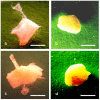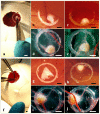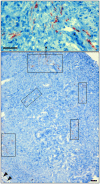Comparison of in vitro- and chorioallantoic membrane (CAM)-culture systems for cryopreserved medulla-contained human ovarian tissue
- PMID: 22479331
- PMCID: PMC3316540
- DOI: 10.1371/journal.pone.0032549
Comparison of in vitro- and chorioallantoic membrane (CAM)-culture systems for cryopreserved medulla-contained human ovarian tissue
Abstract
At present, there are three ways to determine effectively the quality of the cryopreservation procedure using ovarian tissue before the re-implantation treatment: evaluation of follicles after post-thawing xenotransplantation to SCID mouse, in-vitro culture in a large volume of culture medium under constant agitation and culture on embryonic chorio-allantoic membrane within a hen's eggs. The aim of this study was to compare the two methods, culture in vitro and culture on embryonic chorioallantoic membrane (CAM) of cryopreserved human ovarian medulla-contained and medulla-free cortex. Ovarian fragments were divided into small pieces (1.5-2.0×1.0-1.2×0.8-1.5) of two types, cortex with medulla and medulla-free cortex, frozen, thawed and randomly divided into the following four groups. Group 1: medulla-free cortex cultured in vitro for 8 days in large volume of medium with mechanical agitation, Group 2: medulla-containing cortex cultured in vitro, Group 3: medulla-free cortex cultured in CAM-system for 5 days, Group 4: medulla-containing cortex cultured in CAM-system. The efficacy of the tissue culture was evaluated by the development of follicles and by intensiveness of angiogenesis in the tissue (von Willebrand factor and Desmin). For Group 1, 2, 3 and 4, respectively 85%, 85%, 87% and 84% of the follicles were morphologically normal (P>0.1). The immunohistochemical analysis showed that angiogenesis detected by von Willebrand factor was lower in groups 1 and 3 (medulla-free cortex). Neo-vascularisation (by Desmin) was observed only in ovarian tissue of Group 4 (medulla-contained cortex after CAM-culture). It appears that the presence of medulla in ovarian pieces is beneficial for post-thaw development of cryopreserved human ovarian tissue. For medical practice it is recommended for evaluation of post-warming ovarian tissue to use the CAM-system as a valuable alternative to xenotransplantation and for cryopreservation of these tissues to prepare ovarian medulla-contained strips.
Conflict of interest statement
Figures






References
-
- Siegel R, Ward E, Brawley O, Jemal A. Cancer statistics, 2011: The impact of socioeconomic and racial disparities on Eliminating premature cancer deaths. CA A Cancer J Clin. 2011;61:212–236. - PubMed
-
- Cancer in Germany 2005/2006. Abundances and trends. 2010. 120 A joint publication of the Robert Koch Institute and the Association of Cancer Registries in Germany.
-
- Altekruse SF, Kosary CL, Krapcho M, Neyman N, Aminou R, et al. Surveillance, epidemiology, and end results. 2010. Cancer Statistics Review, 1975–2007. National Cancer Institute. Bethesda, MD, USA.
-
- Hovatta O. Methods for cryopreservation of human ovarian tissue. Reprod Biomed Online. 2005;10:729–734. - PubMed
Publication types
MeSH terms
Substances
LinkOut - more resources
Full Text Sources

